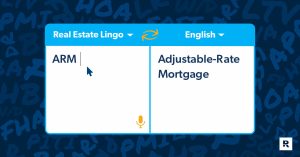kate_sept2004/GettyImages; Illustration by Hunter Newton/Bankrate
Key takeaways
- When you assume a mortgage from a home seller, you become responsible for that loan at its existing interest rate and terms. The seller signs the balance over to you, while you compensate them for the amount they’ve already paid off.
- You can only assume a government-backed loan, such as an FHA or VA loan. Most conventional mortgages aren’t assumable.
- Some borrowers seek out assumable mortgages in order to get a better interest rate than what’s on the market today. An assumable loan can be tough to find, however.
Used cars. Preowned furniture. Secondhand clothing. All of these can be smart, money-saving purchases. The same idea applies to homebuyers who take over, or “assume,” a seller’s mortgage with a lower interest rate than available in the market. You can’t assume any mortgage, however, and the process isn’t as easy as getting a loan on your own. Here’s how it works.
What is an assumable mortgage?
An assumable mortgage allows a buyer to assume the rate, repayment period, current principal balance and other terms of the seller’s existing mortgage rather than get a brand-new loan.
The biggest potential advantage for the buyer is that the terms of the seller’s mortgage might be more attractive than the prevailing terms the buyer would be offered on a new mortgage.
What types of mortgage loans are assumable?
The main types of mortgages that can be assumed are FHA loans, VA loans and USDA loans:
- FHA loans: For FHA assumable mortgages, you’ll need to meet standard FHA loan requirements. These include being able to make a minimum down payment of 3.5 percent with a credit score of at least 580.
- VA loans: You don’t necessarily have to be a member of the military or a veteran to assume a VA loan. If the loan originated before 1988, you will not need permission from the VA or the lender to assume the mortgage. That said, if the loan originated after 1988, any loan assumption must be lender-approved. While there isn’t a minimum credit score, the lender will typically look for a score of 620 and above. You’ll also still have to pay the VA funding fee.
- USDA loans: USDA loans are most often assumed with a new rate and terms, but in some cases, like transfers between families, they can be assumed with the same rate and terms without needing to meet eligibility requirements. To assume a USDA loan, you typically need a minimum 620 credit score. You also have to meet income limits and location requirements.
Are conventional mortgages assumable?
Most conventional mortgages — the most popular type of loan — are not assumable. They contain what’s called a due-on-sale or due-on-transfer clause, which mandates the mortgage be paid in full whenever the original borrower sells the property or transfers the loan.
That said, in special circumstances, you can assume a conventional loan. To know whether your mortgage is assumable, look for an assumption clause in your mortgage contract. This provision is what allows you to transfer your mortgage to someone else.
In most cases, the mortgage lender has to approve the assumption, and typically will hold the new borrower to the loan’s eligibility requirements.
Up until the 1980s, assumable mortgages were the norm. That changed in 1982 with the passage of the Garn-St. Germain Act, which allows lenders to enforce due-on-sale clauses if a property changed hands. Previously, state laws could block such actions. The legislation did specify exceptions to lenders being able to call a loan in, however — often in the case of death or divorce.
How do assumable mortgages work?
When you assume a mortgage, the current borrower signs the balance of their loan over to you, and you become responsible for the remaining payments. That means the mortgage will have the same terms the previous homeowner had, including the same interest rate and monthly payments.
You’ll still need to compensate the seller for the amount of the mortgage they’ve paid off. While this is part of the overall purchase price, you have to pay it right away — essentially as part of your down payment. The funds can come out of your own pocket, or you can finance the sum via another loan.
In addition, you’ll likely need to pay the lender an assumption fee.
Assuming a mortgage after death or divorce
Mortgage assumptions can happen outside of traditional real estate transactions. A family member (or sometimes even non-relatives) can assume an existing mortgage on a home they’ve inherited. If one person is awarded sole ownership of a property in divorce proceedings, that person can assume the full existing mortgage themselves.
In both cases, assumption is allowed even if the contract doesn’t include an assumption clause, or if it’s a conventional loan. In an inheritance scenario, the new borrower does not need to qualify for the loan if they were related to the deceased.
Pros and cons of assumable mortgages
Pros
- Buyer gets a lower interest rate: For buyers, the biggest benefit to assuming a mortgage is the ability to take on the seller’s lower interest rate (assuming rates were lower when the seller purchased the property). This can be an especially attractive outcome in a high-rate environment.
- Seller might attract more offers: If you’re a seller and your mortgage has a lower-than-market interest rate, you could draw more buyers — especially if you haven’t built up much equity in the home.
Cons
- Buyer can’t assume a conventional mortgage, in most cases: The only types of assumable mortgages are FHA loans, VA loans and USDA loans. In addition, when you assume a USDA loan, you’ll likely get a new interest rate and terms, rather than the seller’s potentially lower rate.
- Buyer might not be able to find options: Unless it’s advertised in the listing description or your real estate agent can otherwise find the information, it’s often hard to learn which homes come with assumable mortgages. Many sellers don’t go this route, either.
- Buyer still needs to qualify for the loan: Unless it’s a case of death, you must have the credit and finances to be eligible for the loan you want to assume.
- Buyer needs to pay the seller their equity stake: While you’ll take over the seller’s mortgage and repay that over time, you’re only assuming their outstanding balance. You’ll still need to pay the seller the remaining cost of the home, either out of pocket or with another loan.
- Seller might still be responsible for the debt: If the buyer doesn’t make payments and your lender hasn’t sufficiently released you from the debt, your credit could take a hit.
How to assume a mortgage
To assume another borrower’s mortgage, take these steps:
- Confirm that the loan is assumable – Check that the loan is, in fact, assumable. It’s also a good idea to speak with the current mortgage holder’s lender to confirm first-hand it’ll allow the assumption and that the loan is in good standing.
- Prepare for the costs – You’ll need to make a down payment, but the amount depends on how much equity the seller has. Once the assumption has been approved, you’ll also have to pay closing costs, but these are generally lower when you assume a mortgage compared to getting one on your own.
- Submit your application – The process of assuming a mortgage could look different from lender to lender, but in general, you’ll need to fill out an application, provide proof of income and assets and submit to a credit check.
- Close and sign liability release – If the assumption is approved, you’ll need to fill out paperwork just as you would when closing any other type of home loan. This might include signing a release of liability confirming that the seller is no longer responsible for the mortgage.
Assumable mortgage FAQ
-
To assume a mortgage, your lender has to give you the green light. That means meeting the same requirements that you’d need to meet for a typical mortgage, such as having a good enough credit score and a low debt-to-income (DTI) ratio.
-
The costs associated with assuming a mortgage are often similar to the fees for taking out a new mortgage, but can sometimes be less. These costs might be worth it if the assumable loan comes with a lower interest rate than what you’d be able to get with a new mortgage.
-
It depends. A mortgage takeover can be beneficial in certain situations, such as when the seller’s original mortgage has a lower interest rate than what is currently available on the market. However, the process of assuming a mortgage can be complex and costly, and not all buyers will qualify. If you assume a loan, be sure to have a real estate attorney carefully look over any agreement or contract.
Read the full article here
















